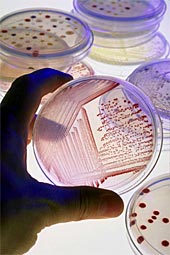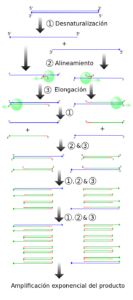
The traditional and most used system currently to isolate microorganisms, , consists of observing their growth in artificial food substances or culture media prepared in the laboratory. Thus each organism grows under specific conditions of pH, temperature, nutrients …
Therefore, the growth of microorganism in particular biological sample (food, water, …) on a specific medium, will indicate the presence and the number of organisms in that environment.
From mid-80s, a new technique was developed. It was PCR (Polymerase Chain Reaction).
Conceptually very simple, the technique is that the enzyme responsible for the synthesis of DNA, DNA polymerase, the DNA to be detected to amplify. For this, two amplified DNA probes, which correspond to part of the genetic material of the microorganism to be detected are added.
The thermocycler is the device that, through successive temperature changes, makes the double strand is separated so that later these small pieces of DNA called primers, which recognize DNA polymerase to synthesize the complementary strand to the spare port is set (see image).
The technique is both simple and effective time. It is used currently for detection of numerous diseases and pathogens.
In the detection of biological samples, such as detection of Legionella pneumophila in a sample of water, has the drawback of false positives can be concluded because no difference between dead and living organisms.

HS Consulting Team

 English
English
 Português
Português  Português
Português 